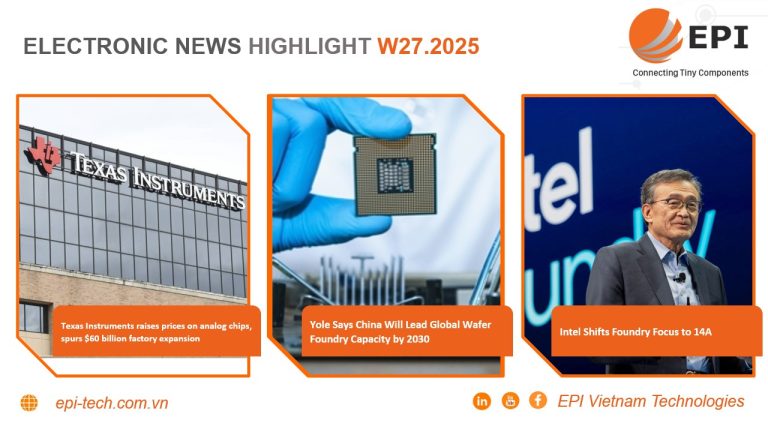ELECTRONIC NEWS HIGHLIGHT W42.2024

1. ST cooperates with Hua Hong to produce 40nm MCU chips in China
ST Microelectronics announced a partnership with Chinese semiconductor foundry Hua Hong Semiconductor to produce 40nm MCU microcontroller chips in Wuxi by the end of 2025. With the aim of strengthening ST’s competitive position in China, especially especially in the rapidly growing EV and industrial sectors.
“China is the world’s largest and most innovative electric vehicle market, and competing effectively here requires local production,” said Jean-Marc Chery, CEO of ST. If we lose market share in China, domestic companies will dominate, using their large local market as a springboard to compete globally.”
ST has expanded its presence in China in recent years. In 2023, the company cooperated with Sanan Optoelectronics to establish a silicon carbide (SiC) joint venture in Chongqing, targeting high-performance chips for electric vehicles. The company also applies best practices and technologies learned in China to its global operations to maintain a competitive advantage. As a leading SiC chipmaker, with customers including Tesla and Geely, ST’s dependence on the Chinese market highlights the company’s strategic importance.
Learn more: ST cooperates with Hua Hong to produce 40nm MCU chips in China
2. Samsung began installing equipment at the NRD-K semiconductor R&D park
Samsung Electronics announced on November 18, 2024 that Samsung held an equipment installation ceremony for its next-generation semiconductor research and development (R&D) complex, NRD-K, located in Giheung, Yongin, Korea. It is expected to begin full operations in mid-2025, with a total investment of 20 trillion won by 2030.
With an area of 109,000 square meters, NRD-K will focus on basic research and product development on memory and logic semiconductor technologies… The complex contains advanced equipment, including system High-resolution extreme ultraviolet (EUV) lithography, advanced material deposition tools, and wafer interconnect infrastructure to create next-generation memory and innovative semiconductor structures.
Samsung aims to make Giheung a hub for advanced semiconductor ecosystems by leveraging NRD-K as a focal point for collaboration with local suppliers of materials, components and equipment.
With NRD-K, Samsung establishes a seamless pipeline from basic research to mass production for next-generation semiconductor technologies, significantly accelerating development progress.
Learn more: Samsung began installing equipment at the NRD-K semiconductor R&D park
3. SK Siltron secures US$544 million loan to increase 8-inch SiC wafer output by 2025
South Korea’s SK Siltron received a $544 million loan from the U.S. Department of Energy DOE to support a silicon carbide SiC wafer fab project in the United States, with the goal of achieving mass production of 8-inch wafers in 2025.
According to industry sources on November 13, 2024, SK Siltron’s US subsidiary, SK SiltronCSS, finalized the master contract for the ATVM Advanced Technology Vehicle Manufacturing loan program with the DOE on November 13, 2024. November 5, 2024. SK Siltron has agreed to receive $544 million in commercial financing through DOE’s ATVM program. The initial loan approval is conditional, pending the satisfaction of specific technical, legal, environmental and financial requirements. Previously, SK Siltron also received $77 million in support from the Michigan state government for a related investment of $300 million in expanding its SiC wafer manufacturing plant.
From 2021 to 2026, SK Siltron plans to invest $640 million in its Bay City, Michigan facility to increase SiC wafer output more than tenfold. The company will only mass produce 150 mm (6 inch) SiC wafers but aims to begin production of 200 mm (8 inch) wafers in 2025, with ongoing investments in research and development to achieve be targeted.
Learn more: SK Siltron secures US$544 million loan to increase 8-inch SiC wafer output by 2025



 English
English  Tiếng Việt
Tiếng Việt 













